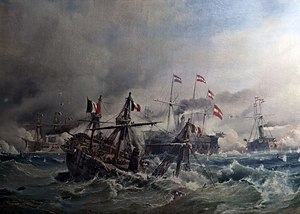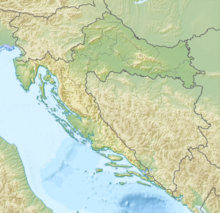This article includes a list of general references, but it lacks sufficient corresponding inline citations. (July 2012) |
| Battle of Lissa | |||||||
|---|---|---|---|---|---|---|---|
| Part of the Third Italian War of Independence | |||||||
 The Sea Battle of Lissa, Carl Frederik Sørensen | |||||||
| |||||||
| Belligerents | |||||||
|
|
| ||||||
| Commanders and leaders | |||||||
|
|
| ||||||
| Strength | |||||||
|
26 ships: 4 ironclads 3 armoured frigates 1 ship of the line 5 screw frigates 1 screw corvette 2 screw gunboats 6 gunboats 1 screw tender 3 steamships |
32 ships: 9 ironclads 1 armoured frigate 2 armoured corvettes 7 screw frigates 1 screw corvette 2 paddle corvettes 1 sloop 3 gunboats 2 avisos 4 merchantmen | ||||||
| Casualties and losses | |||||||
| 176 killed and wounded[1] |
660 killed and wounded[1] 2 ironclads sunk | ||||||
Location within Croatia | |||||||
The Battle of Lissa (or Battle of Vis) (Croatian: Bitka kod Visa) took place on 20 July 1866 in the Adriatic Sea near the Dalmatian island of Vis (Italian: Lissa) and was a significant victory for an Austrian Empire force over a numerically superior Italian force. It was the first major sea battle between ironclads and one of the last to involve deliberate ramming.
The Italian navy fired roughly 1450 shots during the engagement, but failed to sink any Austrian ship and lost two ironclads. This poor performance was largely due to rivalry between the Italian fleet commanders. For instance, Italian Vice Admiral Albini's ships did not engage the enemy.[2]
The engagement was made up of several small battles: The main battle was fought between seven Austrian and twelve Italian ironclads. This battle showed the ability of Austrian Admiral Wilhelm von Tegetthoff to divide his more numerous opponents and then destroy the isolated ironclads.
- ^ a b Stevens (1942), pp. 261–62
- ^ "The Italian "mistakes" in Lissa battle (in Italian)". lastoriamilitare.splinder.com. Retrieved 18 June 2017.
